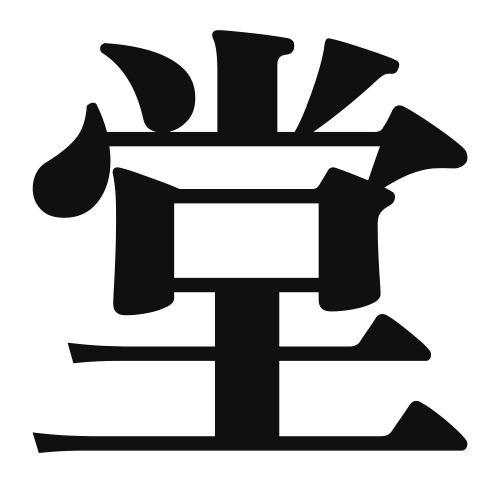1. Overview of Meaning
The kanji “堂” (dō) generally means “hall” or “building.” It is often used to refer to a place where people gather for various purposes, such as ceremonies, meetings, or performances.
2. Formation and Radical
Formation of the Kanji: The kanji “堂” is a phonetic-ideographic character (形声文字). It combines the radical for “building” (土) at the bottom, which represents earth or ground, with the phonetic component “尚” (shang), which contributes to its pronunciation.
Radical: The radical of “堂” is 土 (tsuchi), which means “earth” or “ground.” This radical is commonly associated with structures and buildings.
3. Examples of Usage
Common Words and Phrases: Some frequently used words that include “堂” are:
- 食堂 (shokudō) – cafeteria
- 講堂 (kōdō) – lecture hall
- 礼堂 (raidō) – ceremonial hall
Example Sentences in Daily Conversation:
- 「私たちは食堂で昼食を食べます。」(Watashitachi wa shokudō de chūshoku o tabemasu.) – “We will have lunch in the cafeteria.”
- 「講堂で会議があります。」(Kōdō de kaigi ga arimasu.) – “There is a meeting in the lecture hall.”
4. Synonyms and Antonyms
Similar Kanji: A similar kanji is “館” (kan), which also means “building” or “hall,” but it often refers to larger or more formal structures, such as museums or hotels.
Antonyms: An antonym for “堂” could be “外” (soto), meaning “outside,” as it represents the opposite of an enclosed space or building.
5. Cultural and Historical Background
Relation to Japanese Culture: The concept of “堂” is significant in Japanese culture, often associated with places of worship or community gatherings. Traditional Japanese architecture includes various types of “堂,” such as temples and shrines.
Proverbs and Idioms: One common idiom is “堂々たる” (dōdōtaru), which means “dignified” or “imposing,” reflecting the respect and importance associated with halls and buildings in society.
